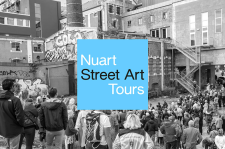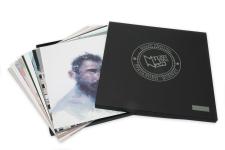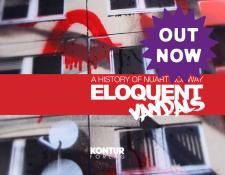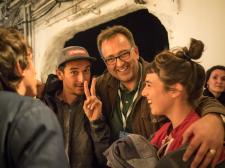
SPACE IS THE PLACE - MARTYN REED
SPACE IS THE PLACE
As many are already aware, after a sustained local campaign by various cultural gatekeepers to reduce the popularity and impact of street art in the city, the Norwegian Arts Council announced that they would be phasing out Nuart Festival’s annual funding. The reason given was a lack of “faglig” competence – for faglig read “professional.” Although, perhaps in this context we can read it as being “not of the profession” – i.e., not belonging to contemporary art praxis proper. On the one hand, this has made life extremely difficult, particularly with regards to paying rent, supporting staff and admin in general. On the other hand, it has helped us to re-focus on who we are and what we’re trying to achieve – and of course, who and what it is we are here to support.
I wanted to take the opportunity to outline some of our ideas in a more reflective way – which I hope will give people a better idea of who we are, and why we do what we do. At the Nuart Festival this year, we’re encouraging artists to work as much as they can outside the framework of the festival, to get off the beaten track and explore the periphery – the side alleys, the edgelands, and those less obvious spots in and around the city – areas with the possibility of creating one to one encounters. This is not to say that we are abandoning the production of large scale works. We recognise that these are an important and valuable aspect of the culture – but to inspire agency in others, we believe it is important to bring street art back to a more human, and less authoritarian, scale. Similarly, we are encouraging contributors to the Nuart Journal to work on the peripheries of interdisciplinary street art scholarship and practice – thus, in our first peer reviewed issue, we have included not just traditional academic articles, but also experimental and visual pieces, and talks and interviews with key thinkers, curators and artists.

The streets function not only as utilitarian arrangements for travel and commerce, but also as deep repositories of meaning for those who occupy and move through them, as places of continually contested perceptions and negotiated understanding. The rise of the ‘neoliberal’ mural scene, has been, in many cases, complicit with the growth of aggressive environmental design through ‘placemaking’ schemes. This is leading to new challenges for organisers, particularly as mural festivals now normatively necessitate significant fees and funding. Getting a Herakut mural up ten years ago was quite different to the considerable logistics, let alone economics, involved in getting one up today. This top down ‘Disneyfication’ of street art culture must be resisted – we need to shine a light back into the margins with the resources and platforms that we have access to. Murals are an important part of the urban garden, but we also need to understand them as being in symbiosis with, and in debt to, the activist, the graffiti writer, the trickster, the sticker, the paste up, the stencil and the tag. In that sense, Nuart is fiercely protective of the term ‘street art’, no matter how corrupted. The ‘street’ is the grit in the oyster that creates the street art pearl, if you like. Or, as Situationist scholar McKenzie Wark (following Lefebvre) would have it, “the maggot within the fruit” (Wark, 2011: 106).
Ultimately, and perhaps – for an organisation – paradoxically, we aim to support the disorganised and unregulated rhythms and movement of the streets, to challenge the regulations of the municipality and institution, and the growing privatisation of not only public space, but also mental space – our very mental environment. In doing so, we hope to act as a counter to the growing forms of spatial exclusion attached to shrink wrapped consumerism and the authoritarian monumentalisation of street art culture that Muralism has achieved.
Street art is now being challenged – so many powerful people and institutions appear to have a vested interest in convincing us to lose faith in street art’s power to effectively respond to, and reveal, our culture’s corporate neoliberal structural mechanisms, one of the first zones being contested is surprisingly in the field of linguistics rather than spatial, Street Art being cynically rebranded as Urban Art, Contemporary Urban Art, Urban Contemporary, the list goes on - anything that strips the dirt and transgressions associated with the street from the art, anything to make it more commercially viable. But conflict – be it linguistic, generational, geographical or economic – is the turbine that drives art forward. Urban public space, the arena in which we practice, is perhaps the primary battleground, an arena where different interests collide and different forces meet. At the same time, and perhaps for the first time in history, it is a stage for broadcasting the ethics, values and ideas of artists who are on the frontline, fighting power and the co-option of the culture whilst chasing happiness through the production of meaningful public work in a post-truth age of Trump, twitter and teargas. This year, Nuart rises to these challenges, initiating new principles for collaboration whilst exploring alternative methods of organising that will hopefully allow the festival, the journal, and street art culture in general, to become adventurous again. A few weeks ago, Nuart general manager James Finucane asked “What is a festival – was Nuart ever a festival”? which gave pause for thought. Eminent geographer Yi-Fu Tuan in his seminal Space and Place (1977) defined place as ‘security’ and space as ‘freedom.’ We areattached to one and long for the other, and perhaps this is what makes Nuart a ‘festival’, providing the security of place whilst offering the freedom of space. It was with this in mind that earlier in the year we decided – in spite of the funding cuts and ongoing campaigns to regulate access to public space – to invite more artists than ever before – twice as many in fact – to organise the disorganisation of the festival and offer the opportunity of greater freedom, of greater space for artists to move through and work in. Uncurating if you like.
This year, the Nuart Festival, takes its title from Sun Ra’s Afrofuturist jazz classic Space is the Place. This is a knowing nod to Geographer Yi-Fu Tuan’s (1977) Space and Place but also a recognition that for some, art is the only way to escape the violence of reality. It’s a call for street artists, urban interventionists, graffiti writers, the marginalised, the dispossessed, the unloved poets, unfashionable artists, academic punks, and out and out outsiders to come together and collectively support the development of a culture that we believe still maintains revolutionary potential. Although to some, at first listen, the abstract overload of Sun Ra’s free improv, with horns squealing and blurting and squawking, keys and organs growing ever more cacophonic, can sound like unlistenable noise, it’s not. Listen again, that tiny flurry of melody, that touch of be-bop – was that MC5, Sonic Youth, now Primal Scream? – that sense of ‘space’, of playfulness, of anything could happen. It’s here, in the musical equivalent of the dense Paris Salon style of display, amongst the wildness and the noise, that we’re able to discover for ourselves, new tones, directions, adventures and insights. A growing realisation that the tail was beginning to wag the dog, that we were in danger of replicating the structural mechanisms of those institutions we set out to critique, has seen a shift in Nuart’s curatorial focus and strategies. Madrid based researcher Javier Abarca (2016) has written insightfully on the creeping dominance of the authoritarian neoliberal Mural scene, rebranded as ‘street art’ festival, and the dangers that come with it: complicity with city developers and gentrification projects, the instrumentalising of art for tourism, murals as placemaking (or placetaking) the somnambulant street art tour, and growing corporate influence. Curators, organisers and artists alike shrug their shoulders in resigned fashion, “whatcha gonna do?”
Hopefully Nuart offers some solutions. It’s the constant risk, and perhaps fate, of the romantic, of subcultures in general: drift into obscurity, or accept the change, calcify into an acceptable form that pays the bills and become classical. This growing compulsion to conform, to look to the perceived successes of the centre, is in danger of defining a culture that is born of the margins, that requires the solitude of what environmentalist Marion Shoard (2002) terms the “edgelands” to survive. The edgelands, the interfacial interzone between urban and rural, and occasionally found within city limits, is where past, present and future collide – where unattended infrastructure constructions, powerboxes, train yards, tracksides, abandoned bridges, beneath highways, water towers overgrown by decades of Ballardian undergrowth attract the tag, the throw up, the practicing stencil artist, the surreptitious paste up, the unschooled artist and poets of the spraycan.

If they’re waiting in the wings for acceptance and admittance into the centre, then no one has told them, but it’s here that we need to be situated, acting as Tarkovsky-like ‘stalkers’ rather than ‘curators’ – opening people up to difficult emotions, hurting them in valuable ways whilst elaborating new forms of play, creating new adventures and new ways of seeing, uncurating the white cube of Alfred Barr’s MoMA, of an art isolated from the world, and filling it with the playful noise of the everyday. We need to free art from the grip of the institution and give it free rein in our cities. Street art is popular at the moment, but that shouldn’t occlude a more critical exploration of how it fits into the everyday – a space vital for what it can be, not for what it currently is. Henri Lefebvre, the Situationists, and Johan Huizinga all recognised the importance of play. If childhood play offers us our first profound experiences of space, of nature, of freedom, then it is here, at a more natural, human and personal scale, that the future of the culture lays, and not at the service of a grand mythical social utopia destined to be co-opted and dominated by corporate placemaking and city planning.
Many artists and researchers, alienated from the risk managed and infinitely measured mainstream, gravitate towards the margins in search of the freedom that unregulated, unmediated and often unpredictable space offers. Walter Benjamin’s introduction of Baudelaire’s flâneur into the academic establishment kick started a contemporary love affair with the idea of removing oneself from the world, becoming a vehicle for the examination of the conditions of modernity, of urban life and alienation. But in a world of growing dislocation, it is a bourgeois conceit to believe that ordinary people going about their ordinary lives are not also capable of the same sort of reflection – and of being inspired by the conditions that have created a need for art in the street.
Tarkovsky’s The Zone, Burroughs’ Interzone, Shoard’s Edgelands, and Hakim Bey’s Temporary Autonomous Zone have all informed Nuart’s thinking, but it is perhaps the thoughts of French Botanist Gilles Clément (2015: 94) writing on nature and the garden, that can be taken as the strongest metaphor for the battles we face in creating and supporting new forms of unsanctioned public art practice:
Garden books don’t mention wild creatures, except how to fight against them, the vagabond has no place here. However, the garden is made from nature, and seeds recognise no boundaries between territory that is policed and space that is wild. For them, anywhere can be inhabited. The constant influx of mobile species represents a considerable force against which the struggle to garden is transformed into a war. There is no lack of arms. In the garden of my childhood, you had to obey the rules: follow implicitly the commercial instructions. We had to smoke out, spray, burn, weed, find every possible way of treating rebellious nature, so disastrously inventive.
At the end of Tarkovsky’s Stalker, a train passes by where the Stalker's family lives – the entire apartment shakes. As the noise of the train begins to subside, the film ends. It is here, trackside, at the edgelands, where the roots of the culture took hold, and it is here that the future of a critical street art should rightly begin.
Martyn Reed, Nuart Festival Founder and Director, August 2018










